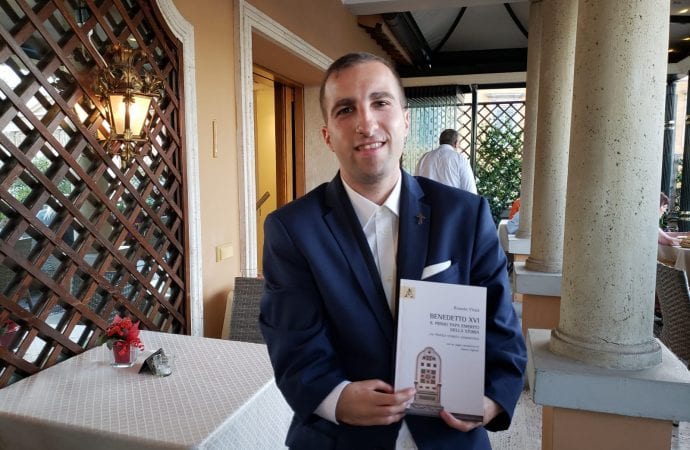In a newly published book, an Italian seminarian argues for filling what he sees as a legal vacuum regarding the status of pontiffs who resign, following Pope Benedict XVI’s abdication in 2013 and his adoption of the unprecedented role of “Emeritus Pope.”
The purpose of the book, the seminarian said, “is to push the Church a little - even though the time might not be quite mature yet - to create a commission … [to] canonically legislate on the legal hole that exists concerning the status of an emeritus pope.”
Rosario Vitale, a seminarian at the Missionaries of the Sacred Heart in Rome, presented his book Benedict XVI: The First Emeritus Pope in History before the Italian parliament June 24.
The world was shocked when Benedict announced his intention to abdicate seven years ago. More surprising still was the fact that the German pope did not choose to return to his homeland of Bavaria in the scarlet robes of a cardinal but decided to keep his white tiara instead and live inside the Vatican, adopting the novel title of emeritus pope.
While it’s rare, popes have resigned before. In his book, Vitale goes though previous cases of pontiffs setting down their tiaras, and in his second chapter focuses on Pope Celestine V’s famous abdication in 1294.
“The abdications of Benedict XVI and Celestine V have several things in common,” Vitale told Crux in a June 26 phone interview. “Both abdicated before a consistory, both read a document [in Latin], both claimed the reason to be old age and physical weakness, and both wished to dedicate themselves to a life of prayer.”
The book, written in collaboration with Italian law professor Valerio Gigliotti, presents documents in Latin that have never before been translated for the public and were written by Celestine V to explain his decision. The document read by Celestine to declare his abdication has unfortunately been lost, but a general synopsis of the words he spoke before the gathered cardinals remains.
Despite the similarities, Celestine V made a show of shedding his papal tiara and robes before the Church hierarchy so he could once again don his monastic attire, as he basically attempted to flee the pontificate. That plan did not work so well for the once-pope who was soon captured and died in prison.
Benedict XVI, of course, did not flee. While having adopted a “monastic” name as pontiff, he is at heart an academic. His desire to “scale the mountain” did not take him further than the Monastery of Mater Ecclesiae atop Vatican hill.
Vitale, who studies canon law at the Pontifical Lateran University in Rome, explained that canonists are essentially divided into two factions when it comes to the status of a retired pontiff. On one side, some believe that the correct title would be “emeritus bishop of Rome” in the fashion of bishops who cease to oversee a diocese.
But the seminarian takes the view that a retired pope should be considered “pope emeritus,” which is the title that Benedict XVI has adopted.
“The pope is not just the bishop of Rome,” Vitale said. “He is also bishop of Rome, but he has a universal jurisdiction over the Church.”
To attribute to a pope who resigned the mere role of emeritus bishop of the diocese of Rome is to “belittle, to secularize what the papacy is,” Ventura said, which risks placing the pope at the same level of any other diocesan bishop.
From a jurisdictional perspective, he added, the pope is no different from other bishops as the titular head of the diocese of Rome, but he also takes on very different roles and responsibilities. According to Vitale, the universal calling of the pontificate does not end after an abdication.
“Paternity, as Pope Paul VI would have called it, remains in that office,” he said. “You can stop exercising the function of a father, but you can never stop being a father.”
Vitale explained that he wishes to push forward the conversation between the two factions, but also to put an emphasis on the complete lack of laws and documents on the issue.
“In the Church, everything that is not legislated has always been cause for great problems,” he said, adding that this might be especially important if other popes choose to abdicate in the future.
In a 2017 book called The Abdication, journalist and scholar Fabrizio Grasso hypothesized that if other popes were to abdicate, the Vatican could become the home of an “exclusive papal club, which could be no other than a proto-parliament.”
Vitale, who happens to come from the same Italian island as Grasso, doesn’t go that far, but suggests that “a reigning pope could give some role to emeritus popes” just as auxiliary bishops in Rome help with day-to-day managing of the diocese.
Of course, the seminarian added, if popes abdicate because of old age or tiredness, he doubts they would be inclined to take on anything too difficult or overbearing.
Perhaps the role of a retired pope is best described in an illustration by the graffiti artist Maurizio Pallotta, or “Maupal,” known in Rome for his illustrations of Pope Francis in the borgo surrounding the Vatican. In his picture of Benedict, which accompanies the book by Vitale, he’s shown bent with his hands on a piano in the peaceful company of the Bible and two curious cats.
Next to the emeritus pope is an open window and a dove pictured with an olive branch, the universal Christian sign of peace.

